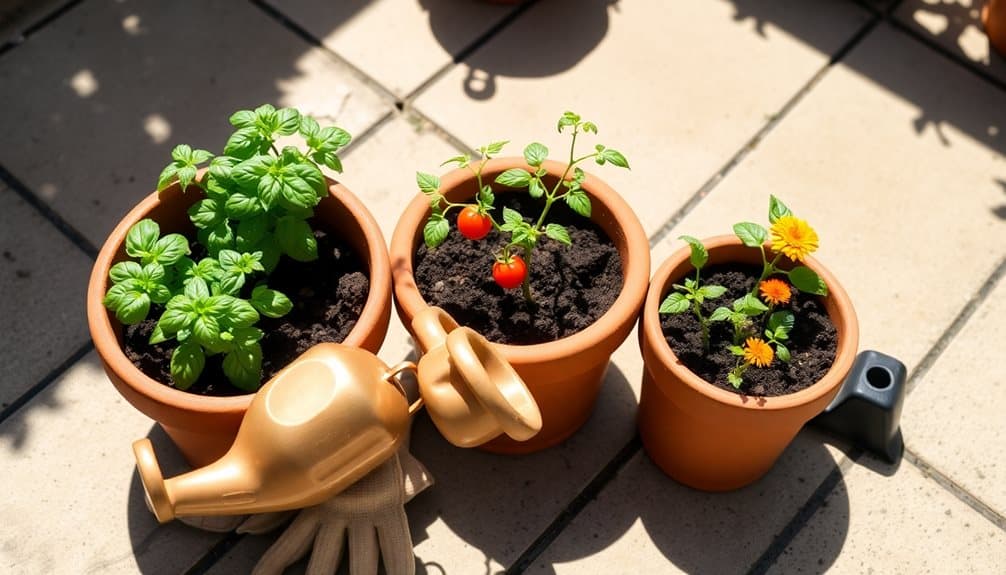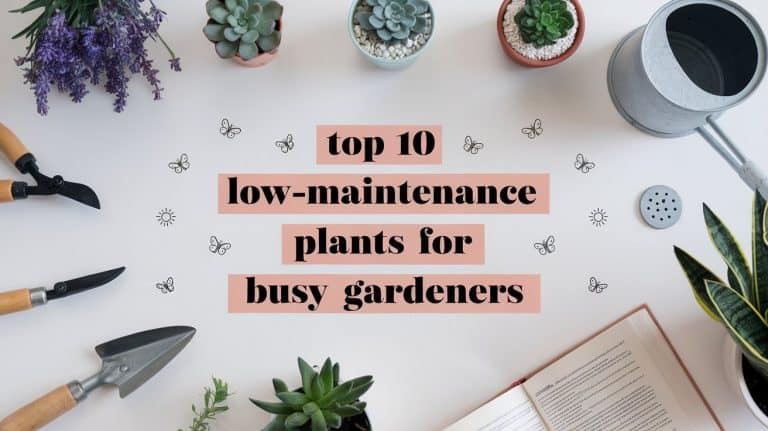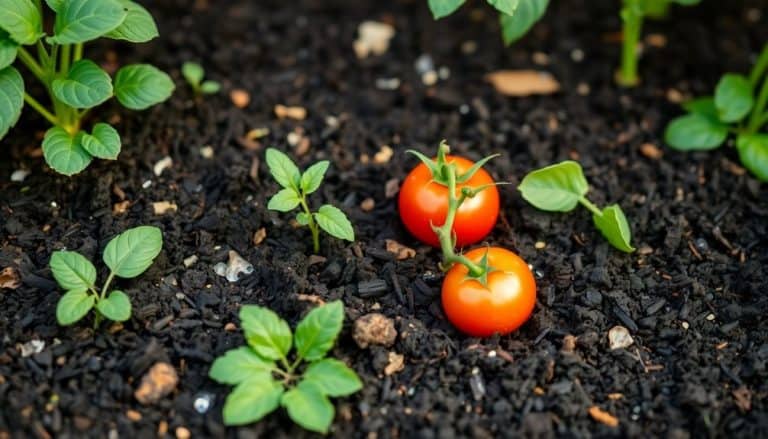This website contains affiliate links. Some products are gifted by the brand to test. As an Amazon Associate, I earn from qualifying purchases. The content on this website was created with the help of AI.
You’ll need several key elements to start container gardening successfully. Begin with containers that have adequate drainage holes and are appropriately sized: 6-8 inches deep for herbs, 10-12 inches for vegetables, and 18-24 inches for larger plants. Use a premium potting mix combining 40% peat moss, 30% vermiculite, and 30% organic matter – never garden soil, which compacts easily. Choose compact plant varieties suited for containers, like determinate tomatoes, bush beans, and herbs. Water thoroughly when soil feels dry to your first knuckle, and fertilize every 2-4 weeks during growing season. Understanding proper soil, drainage, and plant selection will reveal your garden’s full potential.
Key Takeaways
- Choose containers with drainage holes and appropriate sizes: 6-8 inches for herbs, 10-12 inches for vegetables, and 18-24 inches for larger plants.
- Use premium potting soil mix with 40% peat moss, 30% vermiculite, and 30% composted organic matter, avoiding regular garden soil.
- Select compact plant varieties suitable for containers, such as determinate tomatoes, bush beans, herbs, and dwarf peppers.
- Water thoroughly when soil is dry to first knuckle depth, ensuring drainage occurs and watering early in day.
- Fertilize every 2-4 weeks during growing season using balanced fertilizers, monitoring for signs of nutrient deficiency or overfeeding.
Choosing the Right Containers
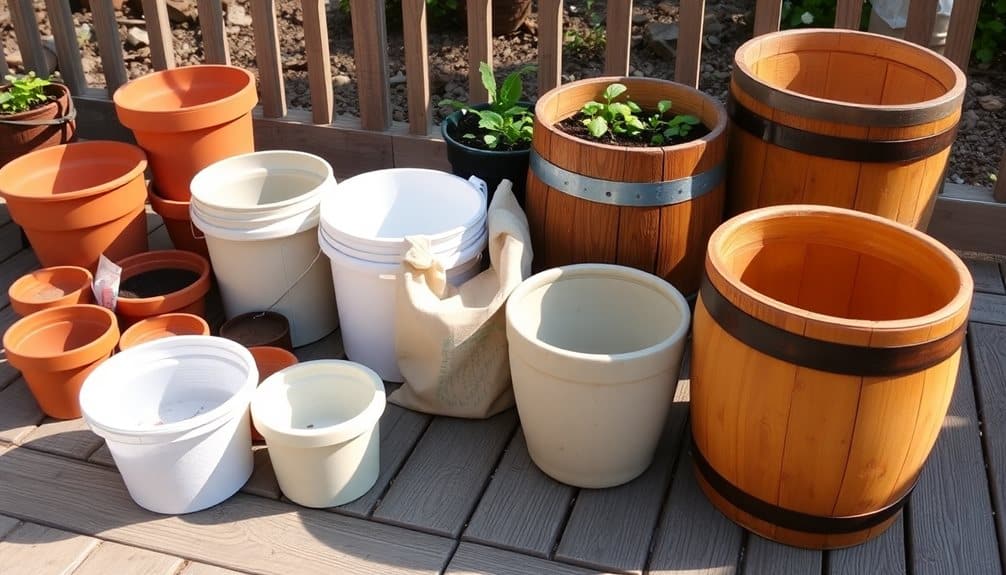
Every successful container garden starts with selecting appropriate vessels for your plants. You’ll need containers with adequate drainage holes to prevent root rot and waterlogged soil. The material you choose affects both plant health and maintenance requirements – terra cotta provides excellent air circulation but dries quickly, while plastic retains moisture longer but offers less breathability.
Size matters considerably in container selection. You’ll want pots at least 6-8 inches deep for herbs, 10-12 inches for most vegetables, and 18-24 inches for larger plants like tomatoes or small trees. Consider the container’s width too – allow 1-2 inches of soil space around each plant’s root ball for ideal growth.
When evaluating containers, check that they’re food-safe if you’re growing edibles. Avoid containers that have held toxic materials or those made with treated wood. Dark-colored containers absorb more heat, which can stress plant roots in hot climates, while light-colored ones reflect sunlight and maintain more stable soil temperatures. Always verify your chosen containers can support the weight of wet soil and mature plants. For tropical plants, consider placing containers on humidity trays filled with pebbles and water to promote optimal growth through increased moisture levels.
Essential Tools and Supplies
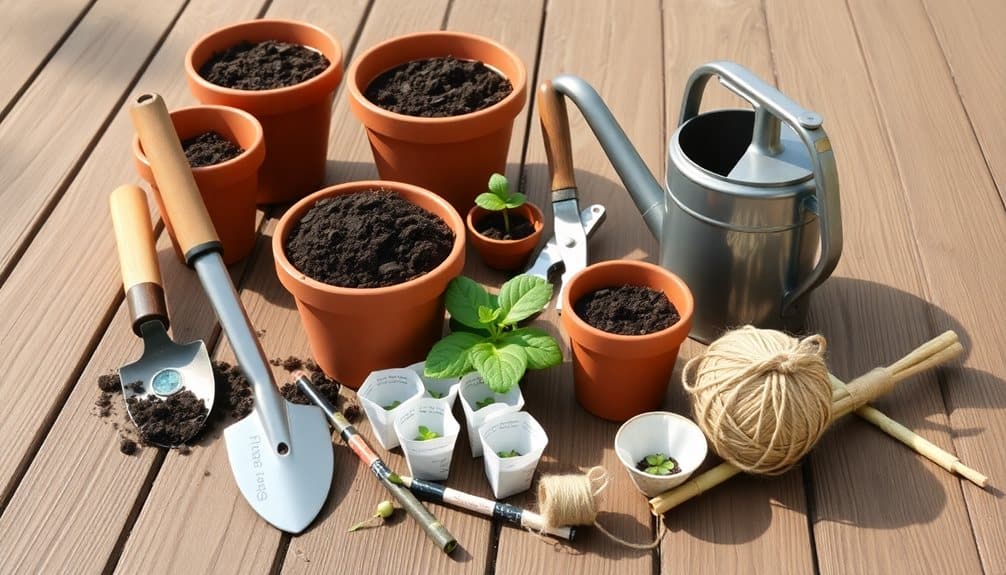
Alongside your carefully selected containers, you’ll need a well-stocked toolkit for successful container gardening. Your essential supplies must include high-quality potting soil specifically formulated for containers, as garden soil is too dense and can harbor pathogens. You’ll also require a hand trowel, pruning shears, and a watering can with a narrow spout for precise irrigation.
For soil preparation and maintenance, invest in a soil moisture meter, pH testing kit, and balanced slow-release fertilizer. Don’t forget drainage materials like gravel or broken pottery pieces. A small cultivator will help you loosen soil and remove surface crusting, while a spray bottle enables targeted pest control and foliar feeding.
You’ll need plant markers to identify your crops and a garden journal to track planting dates and maintenance schedules. For larger containers, acquire a dolly or plant caddy to move them easily. Include cleaning supplies like a brush and diluted bleach solution to sanitize containers between plantings. Finally, keep protective gear handy: gardening gloves, a sun hat, and knee pads for comfort during extended maintenance sessions. Testing soil twice per season helps monitor nutrient levels and ensures optimal growing conditions for your container plants.
Understanding Container Soil Mixes
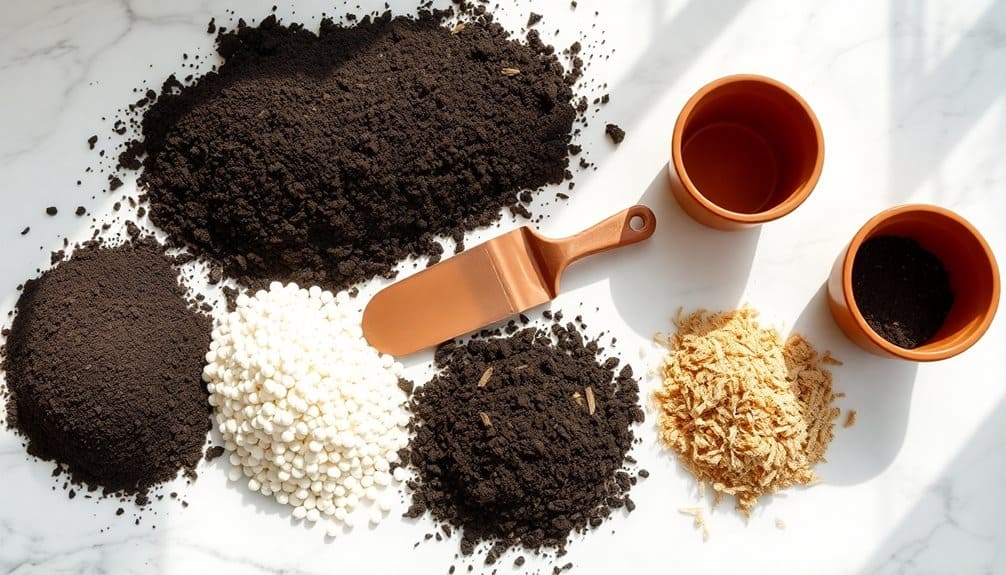
In contrast to traditional garden soil, container soil mixes require specific characteristics to support healthy plant growth in confined spaces. You’ll need a blend that’s lightweight, well-draining, and rich in organic matter. The ideal mix contains three main components: peat moss or coco coir (40%), vermiculite or perlite (30%), and composted organic matter (30%).
Your container mix should maintain proper air porosity, which prevents root suffocation and allows for adequate water drainage. Don’t use ordinary garden soil in containers, as it’ll compact easily and restrict root development. Instead, opt for a soilless medium that’s sterile and free from pathogens.
The pH level of your container mix should range between 5.5 and 7.0 for most plants. You’ll want to incorporate slow-release fertilizers into the mix, as nutrients leach more quickly from containers than garden beds. When selecting commercial potting mixes, look for those labeled specifically for containers and avoid heavy topsoil-based products. For moisture retention, you can add water-holding polymers, though they’re not essential if you’ve balanced your basic components correctly. Many experienced gardeners prefer to purchase premium potting soil for their container gardens to ensure optimal growing conditions.
Best Plants for Container Gardens

When selecting plants for container gardening, you’ll find that certain varieties thrive better in confined spaces than others. For vegetables, compact varieties like determinate tomatoes, bush beans, and dwarf peppers are excellent choices. These plants won’t outgrow their containers and will produce consistent yields throughout the season.
Herbs are particularly well-suited for containers, with basil, thyme, rosemary, and mint being outstanding options. You’ll want to isolate mint in its own container due to its aggressive growing habit. For ornamental plants, consider drought-tolerant succulents, compact flowering perennials like coreopsis and black-eyed susans, or seasonal choices such as petunias and marigolds.
Leafy greens like lettuce, spinach, and Swiss chard adapt exceptionally well to container life and can be harvested continuously. If you’re interested in growing fruit, dwarf citrus varieties, strawberries, and compact blueberry cultivars are viable options. For vertical interest, consider columnar varieties of fruit trees or climbing plants like pole beans and cucumbers, provided you install appropriate support structures. Remember to match plant selections with container size and depth requirements for ideal growth. Root vegetables like carrots and potatoes require 12-16 inches of soil depth to develop properly.
Light Requirements for Success
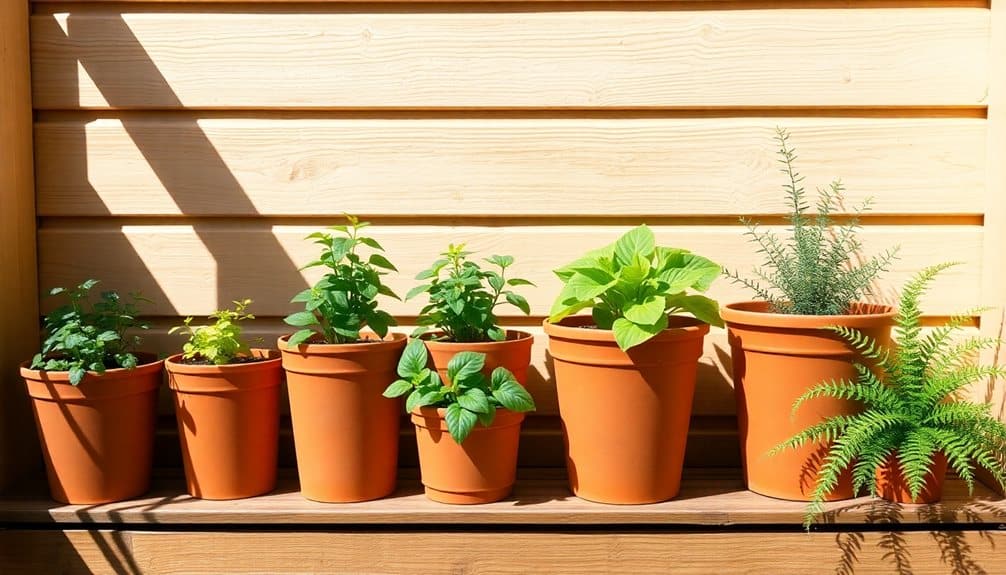
Proper light exposure serves as the foundation for container gardening success, regardless of which plants you’ve selected. You’ll need to understand three primary light categories: full sun (6+ hours of direct sunlight), partial sun/shade (3-6 hours of direct sunlight), and full shade (less than 3 hours of direct sunlight).
To determine your container’s light conditions, track sun patterns throughout the day. South-facing locations typically receive the most intense light, while north-facing areas remain mainly shaded. East-facing spots offer gentle morning sun, and west-facing areas provide stronger afternoon exposure.
You’ll need to adjust your plant selection based on available light. Signs of improper light exposure include yellowing leaves, leggy growth, or scorched foliage. If you’re growing vegetables, most require full sun conditions for ideal yield. Leafy greens can tolerate partial shade, while shade-loving ornamentals like coleus and impatiens thrive in darker spots.
Don’t forget that seasonal changes affect light patterns. You may need to relocate containers as the sun’s position shifts throughout the year to maintain ideal growing conditions.
Watering and Drainage Tips
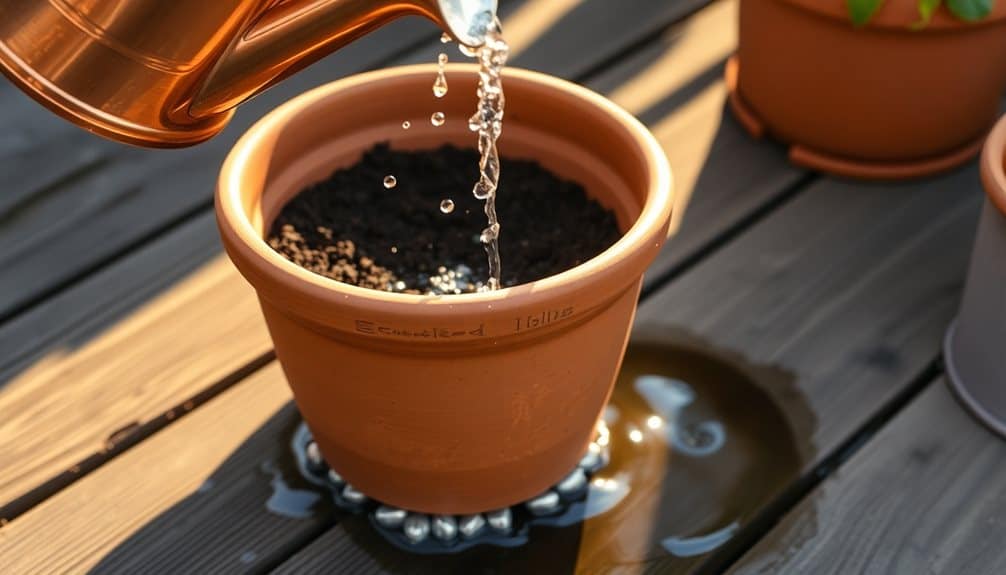
Successful container gardening hinges on achieving the perfect balance between water delivery and drainage efficiency. You’ll need to monitor your containers daily, as potted plants typically require more frequent watering than their in-ground counterparts due to limited soil volume and increased exposure to evaporation.
Insert your index finger into the soil up to the first knuckle – if it’s dry, it’s time to water. When watering, continue until you see water emerging from the drainage holes, ensuring thorough root zone saturation. You’ll want to water early in the day to minimize evaporation and prevent fungal issues that can develop with wet foliage overnight.
Your containers must have adequate drainage holes – at least one 1/2-inch hole for every square foot of soil surface. Don’t place gravel or stones at the bottom of containers, as this actually impedes drainage due to the perched water table effect. Instead, cover drainage holes with mesh screening to retain soil while allowing water passage. If you’re growing in self-watering containers, maintain the reservoir at recommended levels and flush the system monthly to prevent mineral buildup. For consistent and efficient watering, consider installing a drip irrigation system that delivers precise amounts of water directly to your plants’ roots.
Fertilizing Container Plants
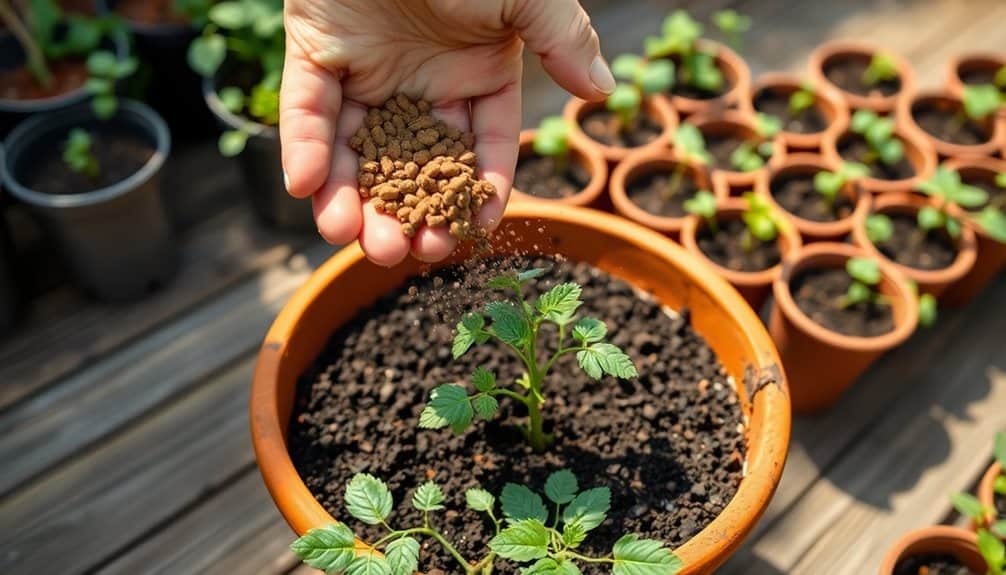
Container-grown plants rapidly deplete their limited soil nutrients, making regular fertilization a cornerstone of healthy growth. You’ll need to apply fertilizer more frequently than in-ground gardens, typically every 2-4 weeks during the growing season. Choose between water-soluble fertilizers, which provide immediate nutrition, or slow-release granules that feed plants gradually over several months.
For flowering containers, select a balanced fertilizer with an NPK ratio of 5-5-5 or 10-10-10, while foliage plants thrive with higher nitrogen formulations like 10-5-5. You’ll want to reduce fertilization by half during fall and winter when plant growth naturally slows. Watch for signs of nutrient deficiency: yellowing leaves often indicate nitrogen shortage, while purple-tinged foliage suggests phosphorus deficiency.
Don’t exceed recommended application rates, as over-fertilizing can burn roots and damage plants. If you’re using organic fertilizers, they’ll release nutrients more slowly and require careful timing to guarantee availability when plants need them most. Always water thoroughly after applying granular fertilizers to prevent root damage and enhance nutrient absorption.
Common Container Gardening Problems
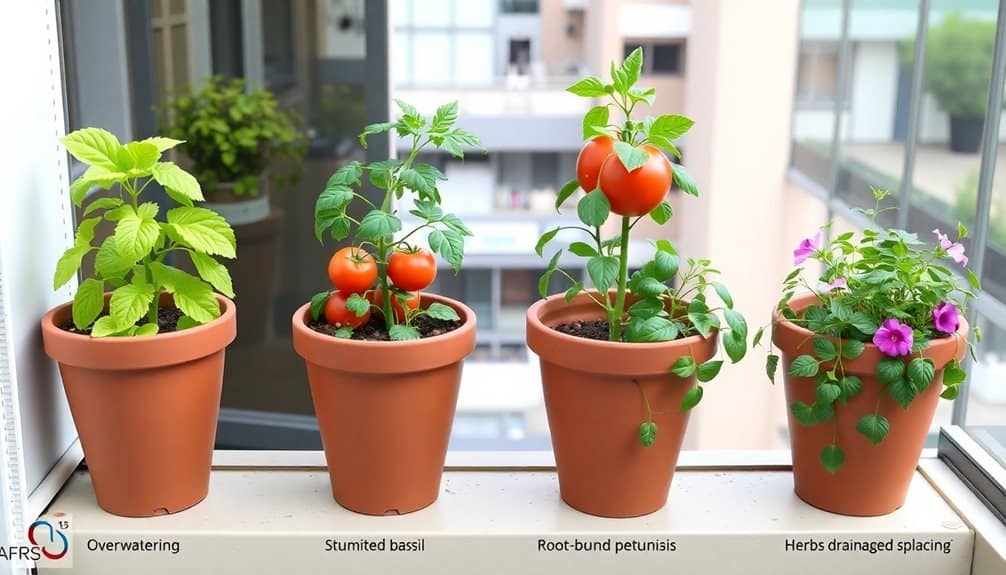
Despite careful maintenance, container gardens often face several distinct challenges that can impact plant health and vigor. Root rot frequently occurs when containers lack adequate drainage or receive excessive watering, leading to oxygen-deprived soil conditions. You’ll notice yellowing leaves, wilting, and stunted growth when this occurs. Similarly, salt buildup from fertilizers can create white crusting on soil surfaces and container edges, requiring thorough leaching with fresh water.
Pest infestations pose another significant threat, with spider mites, aphids, and whiteflies particularly drawn to container plants. These insects multiply rapidly in the sheltered environment containers provide. You’ll need to inspect leaf undersides regularly and treat infestations promptly with appropriate insecticidal solutions. Temperature fluctuations affect container plants more severely than garden-grown specimens, as roots are more exposed to ambient conditions. Your plants may show signs of heat stress or cold damage, including leaf scorch or frost injury. Additionally, nutrient deficiencies manifest quickly in containers, displaying as specific leaf discolorations: yellowing between veins indicates iron deficiency, while purple-tinged leaves often signal phosphorus shortage.
Frequently Asked Questions
How Long Do Plastic Containers Typically Last Before Needing Replacement?
Properly positioned plastic pots typically last 3-5 years outdoors before showing signs of degradation. You’ll notice your containers are ready for replacement when they become brittle, show cracks, or develop UV damage from sun exposure. High-quality, UV-resistant containers can last up to 10 years if you store them indoors during harsh weather. Double-walled plastic planters offer enhanced durability and insulation, extending their lifespan considerably.
Can Multiple Container Gardens Be Placed on Apartment Balconies Safely?
You can safely place multiple containers on your balcony if you follow weight restrictions and proper placement guidelines. Check your balcony’s load capacity, typically 50-100 pounds per square foot. Space containers evenly to distribute weight, and guarantee they don’t block drainage. Use lightweight containers and potting mix when possible, and position them against the building wall for stability. Consider wind exposure at higher elevations.
Should Container Plants Be Brought Indoors During Severe Storms?
You’ll want to bring your container plants indoors during severe storms to protect them from damage. High winds can topple containers, tear foliage, and break stems, while heavy rain can lead to soil oversaturation and root rot. If you can’t move them inside, relocate containers to a sheltered area against walls, secure them with bungee cords, or group them together to create wind barriers.
How Close Together Can Different Container Gardens Be Placed?
You’ll need to space your container gardens based on multiple factors. Allow 6-12 inches between pots for small plants, 18-24 inches for medium-sized plants, and 24-36 inches for large specimens. Consider each plant’s mature spread, light requirements, and airflow needs. Don’t crowd containers, as this can promote disease and create competition for resources. You’ll also want to guarantee you’ve got enough space to access each pot for maintenance.
What’s the Best Time of Day to Transplant Into Containers?
You’ll save countless plants from stress by transplanting in the early morning or late afternoon when the sun isn’t blazing overhead. Early morning is your absolute best bet – between 5:30-9:00 AM – as plants are naturally turgid and temperatures are cool. The gentle morning light helps reduce transplant shock, while evening plantings risk overnight temperature fluctuations that can stress your newly relocated plants.

